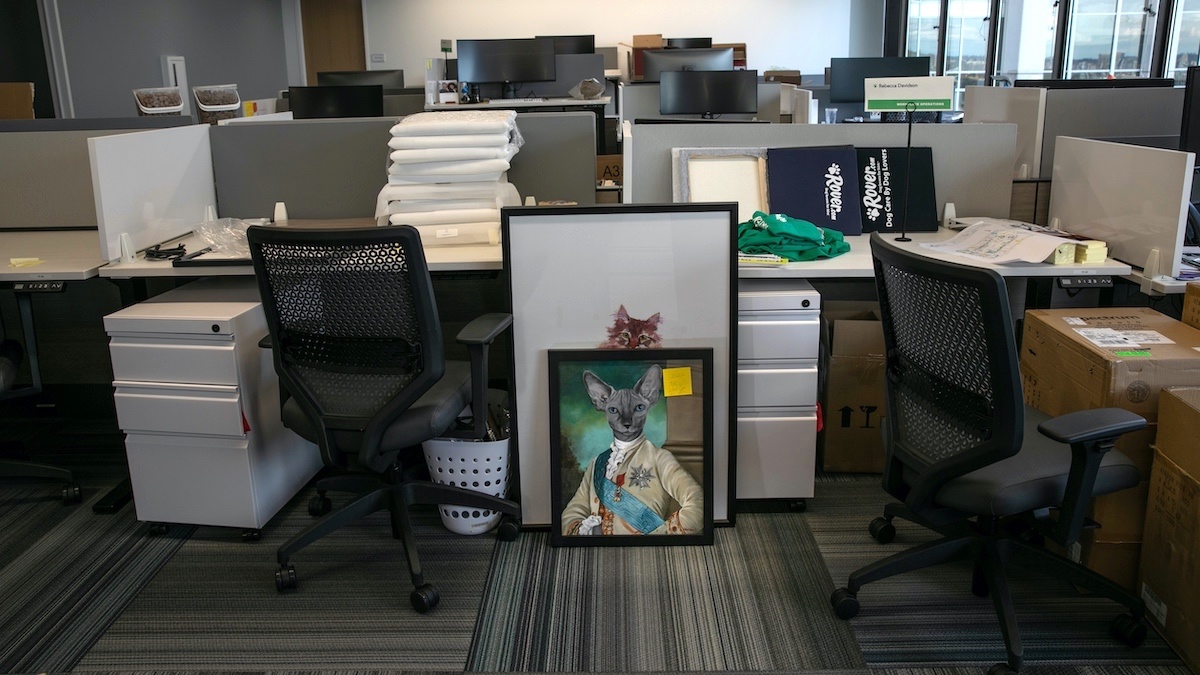

The office of Rover.com sits empty with employees working from home due to the coronavirus pandemic on March 12 in Seattle, Washington. John Moore / Getty Images
The office may never look the same again. And the investment it will take to protect employees may force many companies to go completely remote. That’s after the Centers for Disease Control and Prevention (CDC) issued new recommendations for how workers can return to the office safely.
If companies choose to follow the guidelines, it would lead to a dramatic change in the corporate work experience, and likely increase pollution. One of the most striking features of the recommendations is that they upend years of environmental activism that urged people to take public transportation or car-pool. The new recommendations suggest avoiding public transportation and driving to work alone, as The New York Times reported.
The CDC’s new recommendations suggest making this cost-effective. “Offer employees incentives to use forms of transportation that minimize close contact with others, such as offering reimbursement for parking for commuting to work alone or single-occupancy rides,” the guidelines say.
However, the guidelines did not address the environmental impact of such policies or the health impacts from increasing traffic congestion.
Besides making the commute a lonelier and less environmentally friendly, the guidelines also make the office environment lonelier. The CDC recommends placing workers six feet apart. If that’s not possible, then companies should erect plastic shields around desks, remove seats in common areas, and avoid perks like coffee machines and snack bins that encourage communal activities and many people touching them, according to The New York Times.
In another environmentally damaging recommendation, the CDC does leave room for replacing those items with pre-packaged single-serve coffee and snacks.
“Replace high-touch communal items, such as coffee pots, water coolers, and bulk snacks, with alternatives such as prepackaged, single-serving items,” the guidelines say.
The guidelines also address the technical aspects of the office. The CDC recommends employers ensure that building ventilation systems are operating properly. It also encourages allowing as much fresh air as possible by opening windows and doors, when feasible, to “increase circulation of outdoor air as much as possible,” as Fox News reported.
The guidelines also eliminate many office norms and pleasantries that were once common place. The guidelines tell employers to “[p]rohibit handshaking, hugs, and fist bumps.” It also recommends that employees wear a cloth face mask “in all areas of the business,” as Axios reported.
The guidelines encourage daily health checks, including temperature screenings before employees enter the workplace, and to send home sick workers. Then the office should go through enhanced cleaning and disinfection, as Axios reported.
The New York Times noted that many white-collar offices have successfully transitioned to a fully distributed workforce and are finding that their office environment is able to continue through video conferencing and Slack channels. With that in mind, companies might find the cost of putting protective measures in place too steep, or they might find that isolation in the office makes it difficult to recruit and retain talent. Businesses may decide to allow their workers to stay home.
Already companies like Twitter and Square have decided that their employees never need to come back to the office.
“Companies, surprisingly, don’t want to go back to work,” said Russell Hancock, president and CEO of Joint Venture Silicon Valley, a nonprofit think tank, to The New York Times. “You will not see the drum beat and hue and cry and rush to get back to the office.”
- Trump Admin Rejects CDC Reopening Guidelines - EcoWatch
- Trump Labor Department Encourages States to Report Workers ...
- White House Ordered Coronavirus Meetings Be Classified - EcoWatch
- How to Prevent Coronavirus From Spreading Indoors
- CDC Adds 'Off and On' Brief Encounters to Coronavirus Contact Guidelines - EcoWatch

 233k
233k  41k
41k  Subscribe
Subscribe 